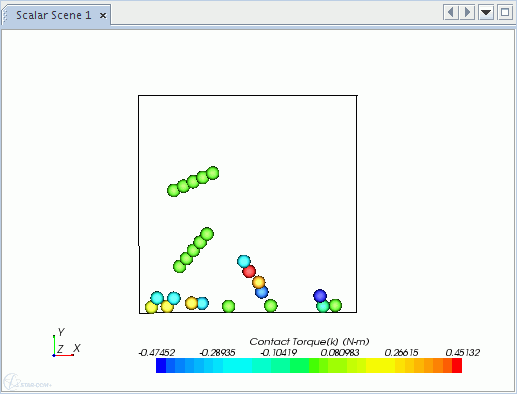Particle Clumps Model Reference
The Particle Clumps model uses multiple shapes (spheres) to represent non-spherical particles. You can use the particle shape editor to define the initial particle assembly.
The join between these spheres is modeled using the Bonded Particles phase interaction model. If you wish to model non-spherical, fixed particles, select the composite particles model.
In contrast to the composite particles model, the particle clumps model defines particles as assemblies of spheres that are connected through parallel bonds. The composite particles model only treats the individual spheres of a particle as separate entities for contact detection, where contacts between particles must be resolved separately. In the remainder of the calculation, the particle is a single object. With the particle clumps model, each sphere in the assembly is treated as an individual particle, with a separate position, velocity, angular velocity, and orientation that are maintained by the system.
When the injector injects a particle, bonds immediately form between particles in contact. The initial configuration of the particle clump is in a state of equilibrium; that is, all the contact forces are balanced.
To make the bonds between particles breakable, select the Simple Failure, Constant Rate Damage, or Impact Cutting model. When the bond breaks, the particles interact according to the Hertz-Mindlin law. The bonding and grain forces do not act in parallel in this case. This fact allows Simcenter STAR-CCM+ to define the initial particle shape without the excessive limitations that the small contact overlap of the soft particle model imposes.
The image below shows an example of particle clumps breaking up as they strike a wall boundary.

Reports, plots, and XYZ internal tables treat all spheres of a clump identically. Each sphere is a DEM particle.
| Theory | See Particle Clustering and Breakup. | ||
| Provided By | |||
| Example Node Path | |||
| Requires |
Under :
Under :
Under :
|
||
| Properties | Key properties are: Number of Spheres, Sphericity, Volume. See Particle Clumps Properties. | ||
| Specific Right-Click Actions | See Particle Clumps Right-Click Actions. | ||
| Activates | Model Controls (child nodes) |
|
|
| Field Functions | Bond State, Normal Bond Stress, Particle Component Index, Particle Diameter, Tangential Bond Stress. | ||
Particle Clumps Right-Click Actions
- Create Shape
- Creates (or re-creates) a composite particle that is based on the selected shape, using the number of spheres currently specified by the Number of Sphere to Generate property.
- Update Properties
- Updates the particle properties that are based upon the current geometry, that is, the user-defined shapes.
- Show Model
- Displays a representation of the particle in the Graphics window.
Particle Clumps Properties
- Principal Moment of Inertia
- Read-only property reporting the product of Principal Moment of Inertia and Moment of Inertia Scaling. Not available with Particle Clumps.
- Area
- Read-only property reporting the area of the particle.
- Volume
- Read-only property reporting the volume of the particle.
- Sphericity
- Read-only property reporting the sphericity of the particle. This property is used when calculating the Haider and Levenspiel drag coefficient (see Eqn. (2977)).
- Number of Spheres
- Read-only property reporting the number of spheres used to fill a part. See Creating Sphere-Filled Parts.
Particle Clumps Field Functions
- Bond State
- Indicates whether any given particle contact is bonded (value 1) or not (value 0). To access this field function, select the Bonded Particles or Parallel Bonds model.
- Normal Bond Stress
- The normal stress in a bond, used in damage and failure modeling. See in Eqn. (3292). To access this field function, select the Bonded Particles or Parallel Bonds model.
- Particle Component Index
- This field function displays the index numbers associated with the spheres composing the particles. Each particle component has a unique index that distinguishes it.
- Particle Diameter
- The particle diameter as that of a sphere of equal volume.
- Tangential Bond Stress
- The normal stress in a bond, used in damage and failure modeling. See in Eqn. (3292). To access this field function, select the Bonded Particles or Parallel Bonds model.
Particle Clumps Input Node
Use the Input manager node to select the input method.
- Method
-
- Manually
- Inserts the Manually node under Input. This node has no properties. Right-click and select New to introduce a new Sphere node. See Working with Individually Composed Shapes.
- Table
- Inserts the
Table node under
Input. This method allows you to load
a particle shape from a pre-existing table. Each table entry
describes one of the spheres in the composite particle. The node
has the following properties:
- Table
- The name of an input table that has already loaded into .
- X Coordinate
- The name of the table column for the x coordinate of the sphere center.
- Y Coordinate
- The name of the table column for the y coordinate of the sphere center.
- Z Coordinate
- The name of the table column for the z coordinate of the sphere center.
- Radius
- The name of the table column for the sphere radius.
- Create Shape
- Creates (or re-creates) a composite particle that is based on the selected shape, using the number of spheres currently specified by the Number of Sphere to Generate property.
- Update Properties
- Updates the particle properties that are based upon the current geometry, that is, the user-defined shapes.
- Show Model
- Displays a representation of the particle in the Graphics window.